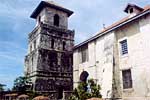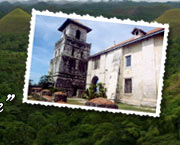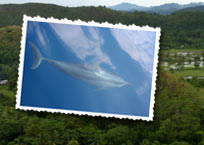A Short History of Bohol (Part I)
IJsselstein, Friday, 29 March 2002 (updated: Monday, 3 December 2007)
Although people have been living on Bohol long before Magellan reached the islands that are now the Philippines, our written records start here, and about the events before that time, little is known, and has to be carefully reconstructed from oral traditions and archaeological evidence.
It is said that around 1200, the Lutaos arrived from northern Mindanao. They build a settlement on stilts in the strait between mainland Bohol and the island of Panglao. This town later became a prospering local center of power, also known as the the "Kingdom of Dapitan." It lasted until it was abandoned in 1563, out of fear for raids by the Portuguese and their allies from Ternate. It will be seen below how this event helped the Spanish to get a foothold in the Philippines.
The Arrival of the Spanish
In 1521, Ferdinand Magellan and his crew were the first Europeans to reach the Philippines coming from the East. When they arrived they weren't really welcome: Magellan himself was killed on Mactan Island near Cebu, by the hand of a local chieftain or "Datu", Lapu Lapu.
Following Magellan's route, the Loaisa Expedition left La Caruņa in Spain on 24 July 1525. This expedition also reached the Philippines, but on the first of June, 1526, a hurricane separated the ships. One of the ships, the Santa Maria del Parral, stranded on on the shore of North-East Mindanao. The survivors were captured and sold into slavery. One of the crew members, Sebastian de Puerto (or de Puerta), came in the hands of the Boholano chief Sikatuna. This is the first contact on record between a Spaniard and a Boholano.
More than forty years after Magellan's demise, in 1564, Spain sent out four expeditions to establish colonies in the Far East, and to pick up a share of the lucrative spice trade under control of the Portuguese. These expeditions failed, but in the next year, Miguel Lopez de Legazpi was more successful. Sailing westwards from Mexico with four ships and almost four hundred men, he reached the Philippines in the beginning of 1565, and established a Spanish settlement.
This wasn't an easy achievement. Just like Magellan before him, Legazpi met with hostile native warriors, who didn't like the idea of foreigners invading their islands. His attempt to land on the island of Cebu was thwarted, and he decided to look for a friendlier place. He lifted his anchor and headed south in the direction of Mindanao. A change of wind, however, forced his fleet back to north in the direction of Bohol. With the help of a Mohammedan Malay pilot from a captured trading ship from Borneo, he learned that the Filipinos were involved in trade with the Moluccas, Borneo, Java, Malacca, and even far away places such as India and China.
The Blood Compact of Legazpi and Sikatuna
Also at Bohol, Legazpi was given a hostile welcome. From his Malay pilot, he learned that this hostility was due to marauding expeditions of the Portuguese. Coming from the Moluccas, the Portuguese raiders traversed the Visayan seas, and just a few years before, in 1563, had plundered Bohol and killed or enslaved about one thousand of its inhabitants. Of course, the Boholano's easily mistook the Spaniards for Portuguese.
Again with the help of his pilot, Legazpi explained two chiefs of Bohol, Datu Sikatuna of Bool and Datu Sigala of Loboc that they were not Portuguese, and had come in peace, and not to plunder or kill. This convinced the Kings to end their hostility and enter pact of friendship. On 16 March 1565 (or 25 March, records are confused due to the Gregorian calendar reform in 1584), Legazpi and Sikatuna performed the now famous blood compact, probably not far from the modern town of Loay. This event is still celebrated in Bohol every year in June with the Sandugo ("One Blood") festival. The same ceremony was repeated three days later with Sigala.
The Conquest of Cebu
After he assured himself of the aid of Sikatuna and Sigala, Legazpi decided to try to establish a permanent Spanish settlement on Cebu. With the native kings as guides, he lifted his anchor and left Bohol on Easter Sunday, and arrived at Cebu on 27 April 1565.
On the shore of Cebu, the local king Tupas already expected them. He had grouped his warriors in full battle array, ready to resist Legazpi and his invaders. In an attempt to negotiate a resolution of the impasse, a priest, father Urdaneta, went ashore, but he wasn't able to convince Tupas. Legazpi then initiated an attack. While the ship's artillery battered the coast, Spanish soldiers landed and attacked the Cebuano warriors. With their superior weapons the Spanish won a victory, and forced the troops of king Tupas to retreat to the hills.
After his defeat, king Tupas was more inclined to enter into peace negotiations. With the help of Cid Hamal, a Mohammedan Malay who stayed in Cebu at that time, a peace treaty was drawn up on the fourth of June 1565. In this treaty, king Tupas recognized the Spanish king as sovereign and agreed to pay a tribute, for which, in return, Legazpi promised to protect him against his enemies and to allow trade between the Filipinos and Spaniards. Also, Legazpi was granted a strategic site on Cebu, where he founded the first permanent Spanish settlement in the Philippines.
Establishment of Catholicism
In the footsteps of the Spanish explorers came the missionaries. About thirty years after the Spanish established themselves on Cebu, on 17 November 1596, two Jesuit priests, Father Juan de Torres and Gabriel Sanchez, arrived in Baclayon, Bohol. It is said that the mother of the encomendero of Bohol, Doņa Catalina de Bolaņos invited them. They established their headquarters in Baclayon, and quickly started to further spread the Catholic faith on the island.
Only a few years after the Jesuits' arrival, on 26 October 1600, Baclayon was raided by some 300 Maguindanao Moros commanded by Datu Sali and Datu Sirongan. In response, the Jesuits moved their headquarters to the inland town of Loboc, at a save distance from the coast. Since then, until the departure of the Jesuits from the Philippines in 1768, Loboc has been the residence of the local Jesuit superior. Here they also founded the first parish on the island in 1602, followed in 1604 by a school, the Seminario Colegio de Indios, a training school for the children of the local ruling class.
The Revolt of Tamblot
The new religion was not easily accepted by all. In the year 1621, Tamblot, a native priest or babaylan called upon the people to return to the faith of their forefathers, and to liberate themselves from the Spanish oppression. Around two thousand Boholanos joined him, and started a revolt when most of the Jesuit fathers were absent, celebrating the feat of the beautification of St. Xavier in Cebu.
When the news of the uprising reached Cebu, the alcalde-mayor Don Juan de Alcarazo, rushed an expedition to Bohol to suppress it. on New Year's Day, 1622, an army of 50 Spaniards and over one thousand Filipinos started their campaign against the rebels. In the following battle, fought out in a torrential rain at Malabago, Cortes, Bohol, the mayor was wounded and the Spanish had to retreat. Six months later, in a second attempt, the rebels where victorious again, but then some Spanish priests from Loboc managed to enter the camp of Tamblot and assassinate him. Then, Without their leader, the insurgents where easily defeated, and Spanish power was restored.
After these events, the Spanish more firmly established their power on Bohol. Using the labor of local workers, a number of magnificent stone churches were built, including the Church of Baclayon, which is one of the oldest stone churches in the Philippines, and was build, in its current shape in 1724, and the church of Loboc with its separate bell-tower.
By 1733, the Jesuits had established six settlements or reducciones: Loboc, Baclayon, Jagna, Talibon, Inabanga and Maribojoc. In these settlements, the people were forced to live together, so that it was easier to Christianize them, as well as to collect taxes.
The Rebellion of Dagohoy
The oppressive methods of the Jesuits once more led to a serious insurrection against Spain. In the year 1744, Francisco Sendrijas alias Dagohoy started a revolt that was to last more than eighty nine years. The cause of this was an incident, in which the brother of Dagohoy was killed. Father Gaspar Morales, the Jesuit curate of Inabanga ordered a this brother, who was a constable, to capture a man who had left the Christian religion. The constable pursued the fugitive, but then was killed by him in a duel. However, when his body was brought back to town, the Jesuit refused the constable a Christian burial.
Infuriated at the priest, Francisco Dagohoy organised the people in an armed rebellion. The uprising started on 24 January 1744 with the killing of the Italian Jesuit curate of Jagna, Father Guiseppe Lamberti. Not long after that, Dagohoy also killed Father Morales, and the rebellion swept over the entire island. In vain, the Bishop of Cebu, Miguel Lino de Espeleta, attempted to calm down the situation, and restore Spanish rule. Dagohoy defeated the troops of Spanish and Filipino forces sent to subdue him. He established a free government in the mountains, and with his followers, was able to control much of the island. Even after Dagohoy's death, his rebellion continued, while the Spanish were only able to maintain their power in some settlements along southern coast.
In the span of 89 years, no less than twenty Spanish governors-generals, from Gasper de la Torre (1739-45) to Juan Antonio Martinez (1822-25), failed to suppress the uprising. In 1825, general Mariano Ricafort (1825-30), became governor-general of the Philippines. He send alcade-mayor Jose Lazaro Cairo to re-establish Spanish power in Bohol. With an army of 2,200 Spanish-Filipino men, he invaded Bohol on May 7, 1827. However, it took more than a year of fierce fighting, and another Spanish expedition under Capitain Manuel Sanz, who landed on Bohol in April 1828, before the patriots were defeated. He captured last remnants of Francisco Dagohoy's rebel forces from their hideout in the Cave of Caylagon. So, finally, by August 31, 1829, the rebellion was ceased. Most of the followers of Dagohoy were pardoned and resettled in new villages in the lowlands. These villages have now become the towns of Batuanan, Cabulao, Catigbian, and Vilar.
In the mean time, in 1768, the Jesuits had been expelled from the country, and their missions taken over by Augustinian Recollects headed by their former Provincial, Fray Pedro de Santa Barbara. Under their leadership, by 1800, the towns of Tagbilaran, Dimiao, Guindulman, Panglao and Loon had been founded.
Jeroen Hellingman
What readers think...
| John Russel Aladao wrote: |
| Tuesday, 7 June 2022 11:56:57 PHT |
| Never been to Bohol but still a proud Bol-anon. My great grandfather served as the Mayor of Sikatuna during Japs invation. He is Ponciano Toledo, we call him Tatay Sanoy. Hopefully the plan for vacation this coming december will not be hindered by the pandemic. |
| Blue Freedom Apnea wrote: |
| Monday, 6 January 2020 12:12:35 PHT |
| There is new freediving school open in Panglao, Bohol. They are non-profit organization that offer AIDA and Molchanovs courses from beginner level to instructor level. If you want to explore Balicasag island in Panglao, you can also do fun dive with them. Checkout their website is https://bluefreedomapnea.com . You can also send an enquiry to their enquiry page Send Enquiry. #freedive #freediving panglao #freediving bohol #freediving philippines |
| John Perry wrote: |
| Friday, 13 January 2017 20:20:02 PHT |
| The Province of Bohol". Ubay Past and Present. The Bohol Provincial Library. 47: 55-57. I'm trying to get this journal, different issues. But I can't find this in any of the normal places. Have you any idea where I can find it/them (online). |
| Belarus wrote: |
| Thursday, 7 May 2015 17:44:02 PHT |
| Kudos to the developers of this website. I was wondering if you could refer me Linguists on Binul-anon language. i am currently working on a language study. I hope you could help me by posting links to reliable sites and journals. I hope it's not too much for you to do. It would really mean a lot to me, being a Boholano by blood. |
| rj_poy wrote: |
| Wednesday, 11 February 2015 08:14:51 PHT |
| For a safe and reliable rent a car company for your Bohol tour? Feel free to reach us.
We provide fully air-conditioned cars/vans accompanied by our knowledgeable and courteous tour driver.
Call us now for a quotation. Cellphone# 0917 324 5488 look for RJ Email Add; hritours@gmail.com |
Read all 149 comments by readers.
Also give your comments on this article
We reserve the right to remove or edit comments posted on this website. Please read our conditions of use for details. You can use <i>italics</i>, <b>bold</b>, <p> new paragraph, <a href="url">link</a>. Other markup will be removed. Use of the forums for advertising is prohibited. Enterprises located in Bohol can request to be added to the business directory.
 Printer friendly version
Printer friendly versionThis article has been viewed 17466 times.

Blood compact monument

Baclayon Church




